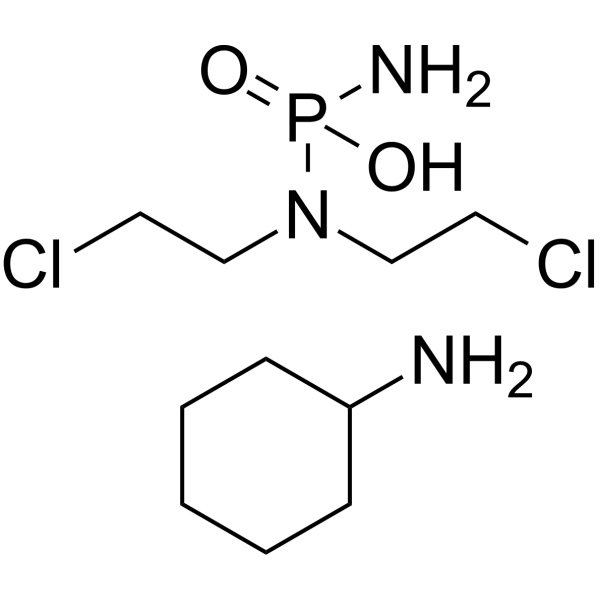Physicochemical Properties
| Molecular Formula | C10H24CL2N3O2P |
| Molecular Weight | 320.20 |
| Exact Mass | 319.098 |
| Elemental Analysis | C, 37.51; H, 7.56; Cl, 22.14; N, 13.12; O, 9.99; P, 9.67 |
| CAS # | 1566-15-0 |
| Related CAS # | Phosphoramide mustard;10159-53-2 |
| PubChem CID | 96355 |
| Appearance | White to off-white solid powder |
| Boiling Point | 363.5ºC at 760mmHg |
| Melting Point | 100-103 °C |
| Flash Point | 173.6ºC |
| Vapour Pressure | 2.84E-06mmHg at 25°C |
| LogP | 3.503 |
| Hydrogen Bond Donor Count | 3 |
| Hydrogen Bond Acceptor Count | 5 |
| Rotatable Bond Count | 5 |
| Heavy Atom Count | 18 |
| Complexity | 197 |
| Defined Atom Stereocenter Count | 0 |
| SMILES | C1(N)CCCCC1.ClCCN(CCCl)P(N)(=O)O |
| InChi Key | BGTIPRUDEMNRIP-UHFFFAOYSA-N |
| InChi Code | InChI=1S/C6H13N.C4H11Cl2N2O2P/c7-6-4-2-1-3-5-6;5-1-3-8(4-2-6)11(7,9)10/h6H,1-5,7H2;1-4H2,(H3,7,9,10) |
| Chemical Name | amino-[bis(2-chloroethyl)amino]phosphinic acid;cyclohexanamine |
| Synonyms | PMC; NSC-69945; NSC 69945; NSC69945; Phosphoramide Mustard cyclohexylammonium salt |
| HS Tariff Code | 2934.99.9001 |
| Storage |
Powder-20°C 3 years 4°C 2 years In solvent -80°C 6 months -20°C 1 month Note: (1). This product requires protection from light (avoid light exposure) during transportation and storage.(2). Please store this product in a sealed and protected environment (e.g. under nitrogen), avoid exposure to moisture. |
| Shipping Condition | Room temperature (This product is stable at ambient temperature for a few days during ordinary shipping and time spent in Customs) |
Biological Activity
| ln Vitro | In order to prevent DNA strand separation during replication, phosphoramide mustard cyclohexanamine forms cross-linked DNA adducts, which are cytotoxic[1]. For a 48-hour period, rat spontaneously immortalized granulosa cells (SIGCs) exposed to phosphoramide mustard cyclohexanamine (3-6 μM) lose viability. Damage to ovarian DNA and the production of DNA adducts are caused by phosphoamide mustard cyclohexanamine (3-6 μM; 24-48 hours). The expression of DNA damage response (DDR) gene mRNA and DDR proteins are increased by phosphoamide mustard cyclohexanamine (3-6 μM; 24-48 hours)[1]. |
| ln Vivo | Rats' subcutaneous tumor growth is inhibited by phosphoramide mustard cyclohexanamine (2.1-20.7 mg/kg; ip; daily; for 5 days)[2]. After intravenous injection (rat 59.4 mg/kg), phosphoramide mustard cyclohexanamine shows terminal elimination half-lives (rat 15.1 min)[2]. |
| Cell Assay |
Cell Viability Assay[1] Cell Types: SIGCs Tested Concentrations: 0.5 μM, 1 μM, 3 μM, 6 μM Incubation Duration: 48 hrs (hours) Experimental Results: decreased cell viability at concentrations of 3 μM and higher. RT-PCR[1] Cell Types: SIGCs Tested Concentrations: 3 μM, 6 μM Incubation Duration: 24 hrs (hours), 48 hrs (hours) Experimental Results: Increased DDR gene mRNA expression levels. Western Blot Analysis[1] Cell Types: SIGCs Tested Concentrations: 3 μM, 6 μM Incubation Duration: 24 hrs (hours), 48 hrs (hours) Experimental Results: Generally increased DDR proteins. |
| Animal Protocol |
Animal/Disease Models: Rat, subcutaneously (sc) implanted Walker 256 carcinosarcoma tumor[2] Doses: 2.1 mg/kg, 4.8 mg/kg , 10.4 mg/kg, 20.7 mg/kg Route of Administration: intraperitoneal (ip)injection, one time/day, for 5 days Experimental Results: Required to produce 50% inhibition of subcutaneous (sc)tumor growth with dose of 12 mg/kg. Animal/Disease Models: Rats[2] Doses: 86.0 mg/kg (pharmacokinetic/PK Analysis) Route of Administration: intravenous (iv)injection Experimental Results: T1/2 (15.1 min). |
| References |
[1]. Phosphoramide mustard exposure induces DNA adduct formation and the DNA damage repair response in rat ovarian granulosa cells. Toxicol Appl Pharmacol. 2015 Feb 1; 282(3): 252–258. [2]. Brain and plasma pharmacokinetics and anticancer activities of cyclophosphamide and phosphoramide mustard in the rat. Cancer Chemother Pharmacol. 1990;27(1):1-7. |
Solubility Data
| Solubility (In Vitro) | H2O : ~100 mg/mL (~312.3 mM) |
| Solubility (In Vivo) |
Solubility in Formulation 1: 100 mg/mL (312.30 mM) in PBS (add these co-solvents sequentially from left to right, and one by one), clear solution; with sonication. (Please use freshly prepared in vivo formulations for optimal results.) |
| Preparing Stock Solutions | 1 mg | 5 mg | 10 mg | |
| 1 mM | 3.1230 mL | 15.6152 mL | 31.2305 mL | |
| 5 mM | 0.6246 mL | 3.1230 mL | 6.2461 mL | |
| 10 mM | 0.3123 mL | 1.5615 mL | 3.1230 mL |
